That feature was followed by Brian Donlevy being cast as "Callendar". A store keeper selling illegal guns to the Indians in the John Wayne feature, "Allegheny Uprising". The productive year of 1939 ended with another Western. Donlevy was Town Boss, "Kent". Who misjudges James Stewart's easy going Deputy Sheriff, "Tom Destry", in Universal Pictures "Destry Rides Again" co-starring Marlene Dietrich.
1940 found Brian Donlevy in two more Westerns. The first as "Grat Dalton" in "When the Dalton's Rode". The other, as "Jim Sherwood", the fictional "Pat Garrett", who goes after Robert Taylor's "Billy the Kid". In 1942 the actor portrayed "Marine Major Geoffrey Caton" under attack by the Japanese Navy's Air Force on "Wake Island". While in 1946, the versatile actor was seen as writer and seaman Richard Henry Dana. In Dana's famous true account of life on an American merchant ship, "Two Years Before the Mast". Then there were two comic roles. First, as Brian Donlevy portrayed "Tom 'T.P.' Paramutual" in 1961's "The Errand Boy" starring Jerry Lewis. Followed, along with Mickey Rooney, as Brian Donlevy learned "How to Stuff a Wild Bikini" in the 1965 "Beach Party" movie starring Frankie Avalon and Annette Funicello.

Above Brian Donlevy, as "Sid Campeau", talking to Joel McCrea in Cecil B. DeMille's 1939 "Union Pacific".
This article is only about five of the one-hundred and twenty-two motion pictures made by Brian Donlevy. These five are normally overlooked or completely unknown.
THE BEGINNING OR THE END released March 7, 1947

The was a nice piece of Hollywood-United States Government propaganda based upon fact and with several real names thrown in. The story originated in 1945, when 24 year old actress Donna Reed and her old Dension, Iowa, high school science teacher came together with a story idea.
That teacher was Edward R. Tomkins who worked at the "Oak Ridge National Laboratory" in Tennessee. The treatment presented to the Government was written by Robert "Bob" Considine the co-author of the best selling account of the "Doolittle Raid", "Thirty Seconds Over Tokyo". The title was supplied by President Harry S. Truman, himself. The screenplay was written for MGM by Frank "Spig" Wead. See the 1957 John Wayne and Maureen O'Hara "Wings of Eagles" about Wead.
The subject matter was "The Manhattan Project" and the creation of the first Atom Bomb and the dropping of it on Hiroshima, Japan.
Twenty of the thirty-seven main roles were actual names of people involved with the project. Below are the six main roles in the production.
Brian Donlevy portrayed "Major General Leslie R. Groves". The real groves was part of the "United States Army Corps of Engineers" and although he oversaw the construction of "The Pentagon". Groves is best remembered for overseeing "The Manhattan Project".

Above Brian Donlevy and below Major General Grooves.

Robert Walker was the fictional "Lieutenant Colonel Jeff Nixon". Walker had been in both 1943's "Bataan" and the 1944 movie version of "Thirty Seconds Over Tokyo". In 1946 he had portrayed the composer of "Show Boat", "Jerome Kern", in MGM's "Till the Clouds Roll By" and in 1951 would co-star in Alfred Hitchcock's "Strangers on a Train".

Tom Drake portrayed the fictional "Matt Cochran". Drake had been "The Boy Next Door" that Judy Garland is in love with in 1944's "Meet Me in St. Louis". He played composer "Richard 'Dick' Rodgers" opposite Mickey Rooney's "Lorenz 'Larry' Hart" in 1948's "Words and Music".
Beverly Tyler portrayed the fictional "Anne Cochran". This was the actresses main role as she was seen usually in forgotten "B" films as either the leading, or supporting actress.

Above Tom Drake, Beverly Tyler and Ralph Dunn as a "Guard".
Audrey Totter portrayed fictional "Jean O'Leary". Some of the actresses other work includes the Lana Turner and John Garfield 1946 crime drama "The Postman Always Rings Twice", Robert Montgomery's interestingly directed Raymond Chandler movie, 1946's "Lady in the Lake", director Michael Curtiz's film-noir, from 1947, "The Unsuspected" with Claude Rains and the Clark Gable and Alexis Smith 1949 "Any Number Can Play".

Above Robert Walker and Audrey Totter.
Hume Cronyn portrayed, "The Father of the Atomic Bomb", "Dr. J. Robert Oppenheimer". Cronyn had been in the 1943 "Phantom of the Opera", both Alfred Hitchcock's 1943 "Shadow of a Doubt" and 1944 "Lifeboat". Hume Cronyn was also in 1946's "The Postman Always Rings Twice". Later, with his wife Jessica Tandy, he would be seen in 1985's "Cocoon" and 1987's "Batteries Not Included".

Above Robert Walker, Hume Cronyn and Tom Drake.
Below Dr. J. Robert Oppenheimer who would be branded a Communist Traitor by Senator Joseph McCarthy.

In 1941 President Franklin Delano Roosevelt, played by Godfrey Tearle, authorizes up to two billion dollars for "The Manhattan Project" and the development of a Antomic Bomb. In December 1942, under the watchful eyes of "Army Lieutenant Colonel Jeff Nixon", scientists at the "University of Chicago" create the first chain reaction.
"Nixon" is assigned to Major General Leslie Groves in overall charge of the project. "Nixon" starts bringing together the scientists and technicians required. FDR dies and Harry Truman, played by Art Baker, continues the authorization for the bomb and Groves moves the project from Manhattan to Los Alamos, New Mexico.
The year is 1945 and physicist and atomic scientist Dr. J. Robert Oppenheimer, while praising the potential of atomic energy for the future, warns of the dangers of such power in the wrong hands. At the same time American scientist "Matt Cochran" with real life scientist Dr. Enrico Fermi, played by Joseph Calleia, and fictional "Dr. Marre", played by Victor Francen, split the atom. Thereby, beating Hitler's scientist to the means of making an Atom Bomb.

Above Brian Donlevy, Audrey Totter, William Wright as the real life "Colonel John Lansdale, Jr" and Robert Walker.

Above Brian Donlevy as "Major General Leslie Groves", Hume Cronyn as "Dr. J. Robert Oppenheimer", Robert Walker, Tom Drake and Joseph Calleia as "Enrico Fermi".
Finally the refining of "Uranium-235" is achieved and the testing of the first Atomic Bomb is successful. With the stiff Japanese resistance in the Pacific Theater of War. President Truman authorizes the dropping of two Atomic Bombs on Japan.

Above Robert Walker and Barry Nelson, as real life Army Air Corps "Colonel Paul Warfield Tibbits, Jr.". The pilot of the "Enola Gay", named for his mother, that drops the Atomic Bomb on Hiroshima.
The fictional characters of now "Colonel Jeff Nixon" and "Matt Cochran" accompany the crew of the "Enola Gay".

While assembling the bomb "Cochran" is exposed to radioactive material and dies. After the plane returns, "Nixon" informs "Cochran's" wife of his death.
The motion picture was something rarely seen in 1947, a "Docudrama", and the film critics were as confused as the public over the picture's motivations.
Bosley Crowther of the "New York Times", on February 21, 1947, wrote:
... despite its generally able reenactments, this film is so laced with sentiment of the silliest and most theatrical nature that much of its impressiveness is marred...In his March 1947 review of "The Beginning or the End". Writer Harrison Brown in "The Bulletin of Atomic Scientists" was troubled over:
a completely false impression of how scientists workThat was attached to a romantic angle between "Matt Cochran" and his wife. That Brown called:
insipid in the extreme
J. Robert Oppenheimer's warning about the dangers of atomic energy became a favorite imaginative subject in 1950's science fiction movies. My look at: "From General Groves and THE MANHATTAN PROJECT to Stanley Kramer/Nevil Shute's ON THE BEACH: Nuclear Holocaust and Post-Apocalyptic Earth in 1950's Science Fiction Motion Pictures" can be found at:
http://www.bewaretheblog.com/2017/05/nuclear-holocaust-and-post-apocalyptic.html
In the 1950's Independent American Movie Producers were turning out a large volume of Science Fiction Movies. Some of these are referenced too in the above link, but others like 1950's "Destination Moon" from producer George Pal. Had been based upon stories by prominent Science Fiction writers. In that case "Rocket Ship Galieo" by Robert A. Heinlein who co-wrote "Destination Moon's" screenplay. Both 1953 features "It Came from Outer Space" and "The Beast from 20,000 Fathoms" are based upon stories by Ray Bradbury. A similar output was occurring across the pond in the United Kingdom and that is where my next two films come from.
QUATERMASS
His name is Thomas Nigel Kneale and he would drop the "Thomas" when creating classic Horror and Science Fiction, That was shown primarily, in the 1950's, by the "British Broadcasting Corporation (BBC)". By the end of his career Nigel Kneale was the winner of the "Somerset Maugham Award", given by the "British Society of Writers", and would have been nominated twice by the "British Academy of Film and Television Arts (BAFTA)" for his screenplays. In 2000 the writer received a "Lifetime Achievement Award" from the worldwide "Horror Writers Association (HWA)".
Some of his Horror and Science Fiction work, although Nigel Kneale wrote some excellent other genres, includes Hammer Films 1957 "The Abominable Snowman". That was released in the United States as "The Abominable Snowman of the Himalayas". Ray Harryhausen's 1964 version of H.G. Wells' novel "First Men in the Moon", and the 1966 Horror film "The Witches". That was released in the United States as 1967's "The Devil's Own". Kneale co-wrote 1982's "Halloween III: Season of the Witch" and the original BBC production of Susan Hill's novel "The Women in Black" in 1989.
However, in 1953, Nigel Kneale created a character known worldwide to true Science Fiction fans "Professor Bernard Quatermass" the head of "The Rocket Group".
The original six part mini-series of "The Quatermass Experiment". Premiered on the BBC, July 18, 1953, and ran approximately three hours. Reginald Tate was the first of eight actors, to date, to portray "Quatermass".
In the early world of British television. "The Quartermass Experiment" pushed Nigel Kneale to become the prominent television writer in the UK.
The success of the BBC program led "Hammer Films" to acquire the rights to the screenplay.
THE QUATERMASS X-PERIMENT was released August 26, 1955

On April 26, 1956 the motion picture was released in the United States as THE CREEPING UNKNOWN

The above American poster looks great, but the illustration of the monster is a close as making it look like a French Poodle,
The first problem facing screenplay writer Richard H. Landau, 1945's "Back to Bataan" and 1951's "Lost Continent", was how to take a three hour teleplay and reduced it to an eighty-two minute feature film? He was assisted by director Val Guest.
Among Guest fifty-six pictures as a director are 1957's "The Abominable Snowman", 1961's "The Day the Earth Caught Fire", 1970's "When Dinosaurs Ruled the Earth" and on television "Space 1999" and "Sherlock Holmes and Dr. Watson". As a screenplay writer, Val Guest wrote, or co-wrote seventy-eight motion pictures and British television shows.
The screenplay was written with the variation in the original title to "The Quartermass X-periment". The dropping of the letter "E" in the word "Experiment" was Hammer's subtle attack on the British Censors. Who would give the picture an "X Rating". Which did not permit anyone under 16 from seeing the picture! Which seemed, in some ways, ridiculous as anyone could have watched the original BBC six-part series in their living rooms two years earlier.
Now director Val Guest was faced with whom to portray "Bernard Quatermas"?
However, even though Anthony Hines, the son of the founder of "Hammer Films", was to be the only name shown in the credits as producer. American Robert L. Lippert, 1950's "Rocketship X-M", both 1951's "The Lost Continent" and "Unknown World", was the real money behind "The Quartermass X-perient" and wanted Canadian-American actor Brian Donlevy to star for International recognition.

Jack Warner portrayed "Inspector Lomax". Warner started his film career with 1943's "The Dummy Talks". He worked with a midget detective posing as his ventriloquist dummy tracking down a murderer. In 1952 Jack Warner co-starred with twenty years old Petula Clarke in the motion picture "The Monster of Killoon". Clarke had been acting since 1944 and singing in movies since 1946. Warner followed this picture with the original 1955 "The Lady Killers" co-starring with Alec Guinness and Peter Sellers.
In the above still, Jack Warner is speaking to Brian Donley.
Margia Dean portrayed "Mrs. Judith Carroon". Chicago born Dean had two small roles in two of director Samuel Fuller's classic motion pictures. She was a "Saloon Singer" in Fuller's psychological look at "Robert Ford", portrayed by John Ireland, 1949's "I Shot Jesse James" and was a "Marquesa", in 1950's "The Baron of Arizona", starring Vincent Price has the real life "James Addison Reavis".
My look at Samuel Fuller entitled "Samuel 'Sam' Fuller: The Ever Present Cigar and Six Movies: 'I Shot Jesse James" 1949, 'The Baron of Arizona' 1950, 'The Steel Helmet' 1951, 'Pick Up on South Street' 1951, 'Shock Corridor' 1963 and 'The Big Red One' 1980" can be read at:
http://www.bewaretheblog.com/2017/02/samuel-sam-fuller-ever-present-cigar.html
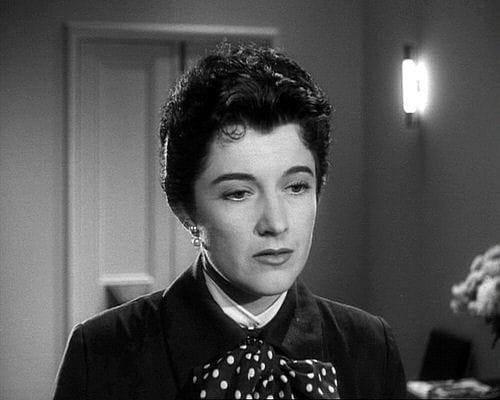
Richard Wordsworth portrayed "Victor Carroon". This was the actors fifth appearance, but the first of only seven feature films. As Wordsworth was primarily a television actor. For fans of
"Hammer Horror" he would also be seen in 1958's "The Revenge of Frankenstein" and 1961's "Curse of the Werewolf".

Richard Wordsworth's "Victor Carroon" is seated in the above photo. He is being examined by the "Rocket Groups" "Dr. Gordon Briscoe" portrayed by David King-Wood. This was only his twelfth feature film of only seventeen.
Lionel Jeffries portrayed Blake". Among his feature films are the 1955 WW2 prisoner of war escape film "The Colditz Story", Ava Gardner and Stewart Granger's 1956 "Bhowani Junction", 1958's "The Revenge of Frankenstein", Audrey Hepburn's 1959 "The Nun's Story" and Ray Harryhaisen's "First Men in the Moon".
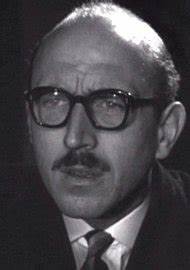
Shortly after the launch of the first manned rocket ship, the "Experiment" of the title, the British "Rocket Group", led by "Professor Bernard Quatermass", looses all contact. Then the rocket comes crashing down into the British countryside.
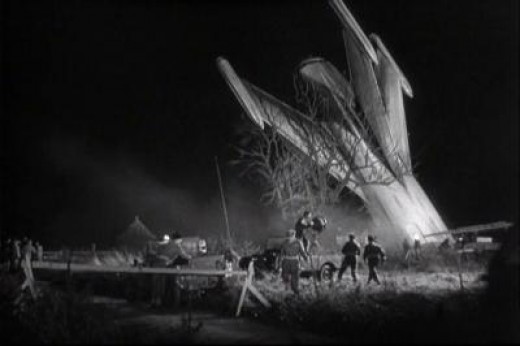
The crew consisted of three men, but apparently only one survived.

At the crash site are the wife, "Judith Carroon", of the only married crewman and sole survivor, "Rocket Group" medical officer, "Dr. Briscoe", and "Blake", one of the government commissioners that was against the launch.
"Victor Carroon" is in a state of shock and his only words are:
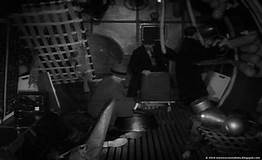
"Victor Carroon" is taken to "Dr. Briscoe's" facilities, because no hospital would know how to treat somebody that went into space.

Scotland Yard Inspector "Lomax" has started an investigation into the disappearance of the other two crewmen and meets with "Quartermass". Meanwhile, "Dr. Briscoe" discovers minor modifications in the facial structure of "Carroon".
Adding to the mystery is that "Lomax" is informed that "Victor Carroon's" fingerprints are not human and joins with "Professor Quartermass" to figure out what's happening. "Judith Carroon" keeps complaining about her husband's treatment at the "Rocket Group" and "Quartermass" reluctantly agrees to move him to a regular hospital, but under strict guard.

What images are found on the rocket ship's camera are finally ready and "Quatermass", "Lomax" and "Briscoe" watch. Something radiating light enters the main cabin and the other two crewmen seem to be absorbed. The jelly like substance found within that cabin has been identified as human tissue.
"Judith", had brought her husband a cactus plant and he seems strangely attracted to it. She also arranges for a man to dress as a doctor and remove "Victor". After getting dressed, "Victor" takes his right hand and smashes the cactus. This leaves parts of the plant in-bedded in his hand and he attempts to hide it from "Judith's" hired man.
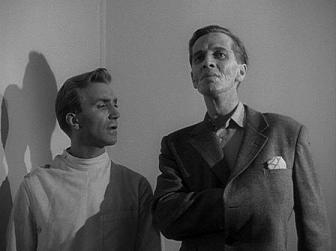
Next in the elevator the hired man asks why "Victor" is hiding his right hand. We see "Victor" raise his hand at him and then there's a cut away to "Carroon" leaving the elevator and meeting with "Judith". Who gets him in her car and drives away. A nurse calls for the elevator and when it opens:

Apparently, "Victor Carroon" has absorbed, as did the living thing in outer space, the other man's life force. "Judith" discovers what is happening to her husband and he leaves her traumatized in the car and disappears into the London fog.
Next "Victor" enters a chemist, pharmacy, shop and kills the chemist leaving him drained also of his life force.
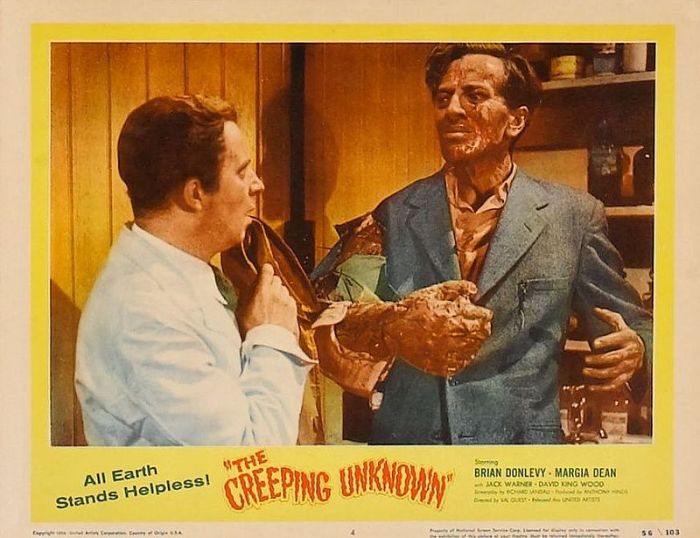
"Quatermass" examining the shop believes only select chemicals were taken to speed up the change occurring to "Victor Carroon". The following morning "Victor" encounters a little girl by a barge, on the Thames, he had been sleeping on. However, he does not harm her and heads for the London Zoo.


"Quatermass", "Lomax" and their combined team arrive at the Zoo to find many animals completely drained of their life force and something else. In the bushes is a strange living thing. It is a part of whatever "Victor Carroon" is becoming and they take it back to "Dr. Briscoe's" lab.

"Quatermass" determines that whatever "Carroon" is becoming. Can duplicate itself like a cactus plant with spores. The hunt is on to find and kill the spores and find "Victor" by a slime trail that he, or it is leaving. As it moves straight up the outer wall of a building.

%2C%2BThe_025.jpg)
The BBC is starting a broadcast from Westminster Abby and the director sees something on the catwalks.
%2C%2BThe_026.jpg)

%2C%2BThe_030.jpg)
"Quatermass" has the television crew attached power cables to the metal scaffolding and electrocute the creature.
%2C%2BThe_029.jpg)
%2C%2BThe_031.jpg)

"The Quartermass X-periment" end with the "Rocket Group's" second manned ship taking off.
Nigel Kneale was not finished with "Bernard Quatermass" and, on October 22, 1955, the first of six-parts appeared once more on the BBC as "Quatermass II". This time starring John Robinson as the third actor to portray the "Professor". Actually Anderson was a minor supporting actor on television and in films and is remembered only for this role.

On May 10, 1957 Hammer Films, Nigel Kneale and and Val Guest released the eighty-five minute version of the three hour BBC program still as "Quatermass II".

In September of 1957 the feature reached the United States as "Enemy from Space".

Brian Donlevy was back as "Professor Bernard Quatermass".
John Longden was now "Lomax". Longden had been acting since 1926 and appeared in the Vivian Leigh and Sir Ralph Richardson 1948 version of Leo Tolstoy's "Anna Karenina", but mostly in UK "B" pictures and starting in 1951 television.

Sidney James portrayed "Jimmy Hall". Hall was part of the "Carry On" comedy group and did the occasional drama and appeared on several British comedy television programs.

Bryon Forbes portrayed "Marsh". Forbes was in two WW2 prisoner of war escape films based upon real events, 1950's "The Wooden Horse" and 1955's "The Colditz Story". Forbes was also a screenplay writer and his work included the prisoner of war movie 1965's "King Rat" and 1992's "Chaplin". Among his work as a motion picture director was his own "King Rat" and 1975's original "The Stepford Wives".

Above Brian Forbes and Brian Donlevy.
While attempting to get funding for his "Moon Colonization Project". Reports start coming in about hundreds of meteorites landing in Winnerden Flats looking like small rocket ships.

Taking "Marsh" with him, "Quatermass" travels to the community to find his own "Moon Colonization Project" there.

"Marsh" finds an undamaged "V-shaped" rock that bursts open and sprays his face leaving a "V-shaped" mark on it. Guards, with the same mark, come out from the copy of the "Moon Colonization Project", take "Marsh" away, leaving "Quartermass" just standing there.

"Quatermass" now goes to "Inspector Lomax" for help and is introduced to "Member of Parliament Vincent Broadhead", played by Tom Chatto. Both join "Broadhead's" tour of the facility they enter the complex.

"Broadhead" sneaks away and attempts to get into one of the three enormous domes in the complex. "Professor Quartermass" finds him covered in a poisonous black slime and dying.


"Quatermass" and "Lomax" turn to Journalist "Jimmy Hall", but he is skeptical of their story.

However, he joins the other two and they go to the village that is providing labor to construct the facility. The villagers are against the three men until one of the meteorites crashes through the pub roof and injures "Sheila", played by Vera Day. Guards from the complex enter and machine gun "Jimmy Hall" as he's talking to his newspaper.
The villagers form a mob and with "Quatermass" and "Lomax", rush the complex and barricade themselves in the pressure control room. Watching the rocks being put into a tube to extract the alien life forms. "Quartermass" realizes that just like the airless moon would be to colonists from the Earth. The reverse is occurring here and the domes contain the atmosphere the aliens need to survive. He sabotages the system pumping oxygen into the domes.
Meanwhile, "Brand", played by William Franklyn, an assistant to "Quatermass" will sacrifice his life by launching a "Rocket Group" rocket at the asteroid believed to be the invasions home base. The invaders now fuse themselves into one creature in each of the three domes and 150 foot aliens emerge.



The nuclear warhead in the rocket explodes the asteroid and on Earth, exposed fully to our atmosphere, the alien giants collapse and die. On all the infected people, the "V-shaped" mark disappears and they have no memories of what happened to them.
In June 1957 a short story by French-British author George Langelaan was published in "Playboy Magazine". The story starts as a murder mystery asking why a loving wife violently murdered her husband and evolves into a Science Fiction and Horror story.
In 1958, "The Fly" became a motion picture starring Vincent Price as "Francois Delambre" investigating his brother's murder. David Hedison was "Andre Delambre" the murdered brother and the title character.

In the screenplay young actor Charles Herbert portrayed the added character of "Andre" and "Helene Delambre's", played by Patricia Owens, son "Philippe". Who is searching for the fly with the white head.

Above Herbert Marshall as "Inspector Charas", Vincent Price and Charles Herbert.
Herbert would have the starring role in several films including William Castle's original "13 Ghosts" in 1960. My article on Charles Herbert and Richard Eyer, the genii in Ray Harryhausen's "The 7th Voyage of Sinbad", entitled "Richard Eyer and Charles Herbert: Youthful Actors" can be read at:
http://www.bewaretheblog.com/2016/06/richard-eyer-and-charles-herbert-child.html
In 1959 Vincent Price was back as "Francois" and Brent Halsey portrayed the now adult "Philippe", and carrying out his father's experiments. However, he is turned into----

The film has a happy ending and "Philippe" is returned to normal and his girlfriend.
Most of my readers may know of director David Cronenberg's 1986 remake of "The Fly". However, what gets lost is that there was an actual second sequel to the 1958 motion picture.
"THE CURSE OF THE FLY" released in May 1965

Among Australian director Don Sharp's films were Hammer Films 1963 "Kiss of the Vampire", and with Christopher Lee, 1964's "Devil Ship Pirates" and 1966's "Rasputin the Mad Monk". He also directed Lee in 1965's "The Face of Fu Manchu" and 1966's "The Brides of Fu Manchu".
Canadian Harry Spalding wrote the screenplay. Among his forgotten low budget films are 1961's "Teenage Millionaire", 1962's, so terrible its good, "The Day Mars Invaded the World", 1964's "The Earth Dies Screaming" and 1965's Spaceflight IC-1: An Adventure in Space".
Brian Donlevy portrayed "Henri Delambre". The son of "Andre" not "Philippe" who is never mentioned in the screenplay.

George Baker portrayed "Martin Delambre". Baker was mainly a British television actor, but he portrayed "Sir Gawaine" in the excellent, but overlooked 1963 "Sword of Lancelot" starring Cornel Wilde and appeared in two "James Bond" entries, 1969's "On Her Majesty's Secret Service" and 1977's "The Spy Who Loved Me".

Above Donlevy is speaking to George Baker as his son and "Andre's" grandson in this screenplay.
Carole Gray portrayed "Patricia Stanley". Gray only has 13 roles to her credit, but some of them are interesting. On British television she was in an episode, each of Roger Moore's 1962 "The Saint" and one of "The Avengers" with Diana Rigg. Carole Gray appeared in the 1966 Terence Fisher directed movie "Island of Terror" starring Peter Cushing and in Don Sharp's "The Brides of Fu Manchu".

Above George Baker as "Martin" with his new wife "Patrica" played by Carole Gray.
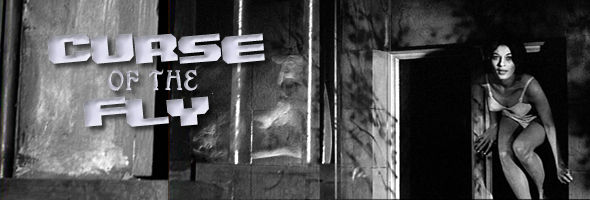
Driving on a deserted highway, late at night, "Martin Delambre" sees "Patricia Stanley" running in her underwear in the direction he's traveling. He stops and picks up the young women. They fall in love and are married.

Of course both "Martin" and "Patricia" hold secrets. When he first saw her, she was escaping from a mental institution. He, on the other hand, is working with his father, "Henri", on teleportation experiments related to the film's title.
"Martin" introduces his father to his new bride. What she does not know is that "Martin's" first wife, "Judith", played by Mary Manson, is alive and a victim of their teleportation experiments. Between the families rural Quebec, Canada, mansion and brother "Albert", played by Michael Graham, in London, England. "Albert" wants to terminate the experiments that have obsessed his grandfather, father and brother.

"Martin" stays young looking from a serum he and his father have created. Otherwise, he will grow old and die, because the life span of a fly is a matter of hours.
Meanwhile, "Inspector Ronat", played by Jeremy Wilkins, is investigating "Patricia's Stanley's" escape from the mental institution and learns of her marriage. "Ronat" now visits a much older "Inspector Charas", played by Charles Carson, at a hospital. "Charas" investigated the murder of "Andre Delambre". The old detective tells the younger the history of the "Delambre"family starting with "Andre" and, keeping with the screenplay, never mentions a son named "Philippe", but two brothers "Martin" and "Albert".

Above Jeremy Wilkins and below Charles Carson.

"Charas" shows what is suppose to be a photo of "Andre", but it is actually from 1959's "The Return of the Fly". There is no fly creature in this picture.
Meanwhile, "Patricia" discovers the truth about her husband and "Judith Delambre".


"Judith" will be killed by servant "Tai", played by Burt Kwouk. Who played Peter Sellers' houseboy in the "Pink Panther" movies.


The police are now closing in and "Henri" and "Martin" decided to eliminate signs of their work. They kill all their subjects and destroy the bodies.Then teleport their two lab assistants, but on arrival in London. The two have become a twisted mass joined together and "Albert" kills it with an axe. In disgust, "Albert" then destroys the teleportation equipment and leaves the lab.


"Tai" and his wife "Wan", played by Yvette Rees, leave before the police can arrive.
"Patricia" is now unconscious and "Henri" wants to teleport her to London, but "Martin" is afraid she will be harmed. To prove otherwise, "Henri" says he will go first and then call "Martin". Placing his father in the transporter "Henri" is sent into nothingness as "Albert" had destroyed the receiving machine. Now "Martin" places "Patricia" in the teleportation case. She comes around and will escape, before the teleportation sequence engages.

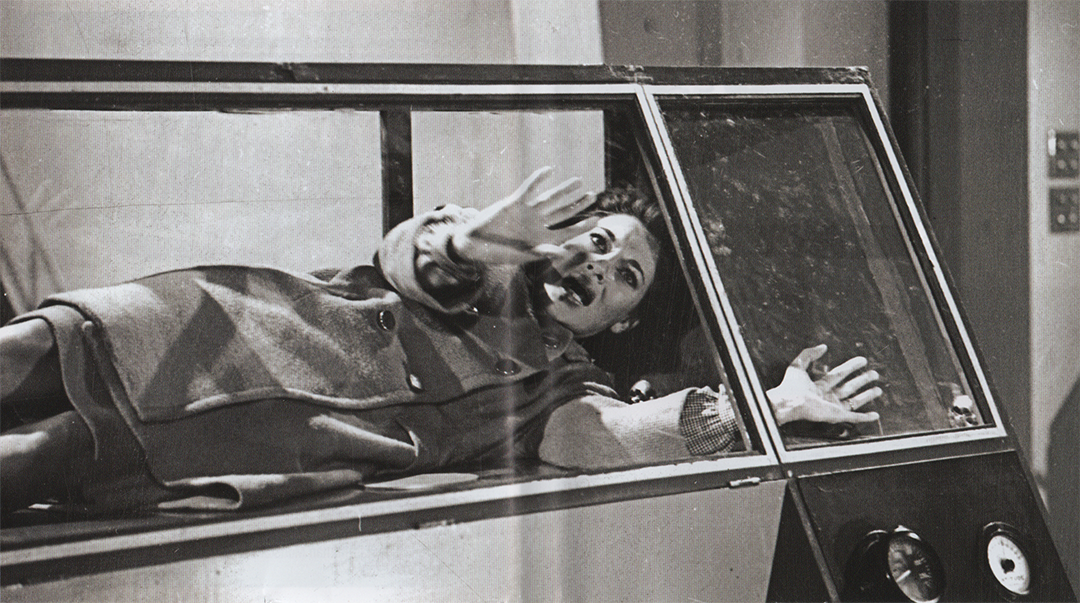
"Inspector Ronet" arrives as his car passes "Tai" and "Wan" in their's on the highway. "Martin" is after "Patricia", but starts aging as she runs outside to his car. "Martin" keeps aging as he attempts to pull "Patricia" from the car's front seat. "When "Ronet" reaches the car there is only a skeleton of what was once "Martin Delambre" and the detective walks the shocked "Patricia" back to the house.
During the 1950's several Japanese Science Fiction films came to the United States. The most famous was 1954's "Gojira". That would be re-edited, have additional footage of actor Raymond Burr added, and dubbed into English. Thus changing the original purpose of the picture into 1956's "Godzilla, King of the Monsters" for American consumption. Another example was 1956's "Radon, Giant Monster of the Sky". Which would have part of the opening footage removed, add an American Atom Bomb test at the beginning, and remove other footage. No American actor was added, but the film was dubbed into English as 1957's "Rodan". There were other examples of this technique to Americanize Japanese Kaiju films. One of these films came from Daiei Studios and would seem to star Brian Donlevy.
GAMMERA THE INVISIBLE released December 15, 1966
The motion picture was directed by Sandy Howard. Howard had directed only eight other programs and that started with the popular 1947 through 1959 Children's television show "Howdy Doody". As a producer between 1958 and 1989 he made thirty-nine features and television shows.
Also listed as co-directer was Noriaki Yusssa His name should have been a tell when I saw the picture.

Brian Donlevy portrayed "Army General Terry Arnold".

Albert Dekker portrayed "The U.S. Secretary of State". In 1940 he appeared in the Paramount Pictures Technicolor Science Fiction film "Dr. Cyclops". Dekker was the doctor who shrinks people and is made the title character when they break one lens of his only pair of glasses. Normally the actor appeared in Gangster Dramas and Westerns. Among his other films are director Robert Aldrich's classic "Mike Hammer" film, 1955's "Kiss Me Deadly". Albert Dekker was one of the Foreign Legionnaires in 1939's "Beau Geste", a soldier in 1942's "Wake Island", a sailor in 1946's "Two Years Before the Mast", and his final on-screen appearance was in director Sam Peckinpah's 1969 "The Wild Bunch".

Director Sandy Howard re-edited "Daikaiju Gamera (Giant Monster Gamera)" removing scenes, adding American footage, and dubbing the Japanese actors in the original November 27, 1965 Japanese release. Like with 1956's "Godzilla, King of the Monsters", 1959's "Gigantis, the Fire Monster" and 1962's "Varan the Unbelievable". The idea was to make movie audiences think they were seeing an American made motion picture.
The American release ran eighty-six minutes, but the original Daiei film only seventy-three minutes.

The story of both versions basically is the same except that it is the American's that create and execute "Plan Z". After a lot of footage of discussions sitting around a table.
An unknown aircraft is shot down over the Arctic Circle and crashes and unleashes an atomic bomb blast that wakes Gamera, or Gammera, from its sleep. Think of this as a variation of Ray Harryhausen's 1953 "The Beast from 20,000 Fathoms", seen below.
Margia Dean portrayed "Mrs. Judith Carroon". Chicago born Dean had two small roles in two of director Samuel Fuller's classic motion pictures. She was a "Saloon Singer" in Fuller's psychological look at "Robert Ford", portrayed by John Ireland, 1949's "I Shot Jesse James" and was a "Marquesa", in 1950's "The Baron of Arizona", starring Vincent Price has the real life "James Addison Reavis".
My look at Samuel Fuller entitled "Samuel 'Sam' Fuller: The Ever Present Cigar and Six Movies: 'I Shot Jesse James" 1949, 'The Baron of Arizona' 1950, 'The Steel Helmet' 1951, 'Pick Up on South Street' 1951, 'Shock Corridor' 1963 and 'The Big Red One' 1980" can be read at:
http://www.bewaretheblog.com/2017/02/samuel-sam-fuller-ever-present-cigar.html

Richard Wordsworth portrayed "Victor Carroon". This was the actors fifth appearance, but the first of only seven feature films. As Wordsworth was primarily a television actor. For fans of
"Hammer Horror" he would also be seen in 1958's "The Revenge of Frankenstein" and 1961's "Curse of the Werewolf".

Richard Wordsworth's "Victor Carroon" is seated in the above photo. He is being examined by the "Rocket Groups" "Dr. Gordon Briscoe" portrayed by David King-Wood. This was only his twelfth feature film of only seventeen.
Lionel Jeffries portrayed Blake". Among his feature films are the 1955 WW2 prisoner of war escape film "The Colditz Story", Ava Gardner and Stewart Granger's 1956 "Bhowani Junction", 1958's "The Revenge of Frankenstein", Audrey Hepburn's 1959 "The Nun's Story" and Ray Harryhaisen's "First Men in the Moon".
Shortly after the launch of the first manned rocket ship, the "Experiment" of the title, the British "Rocket Group", led by "Professor Bernard Quatermass", looses all contact. Then the rocket comes crashing down into the British countryside.

The crew consisted of three men, but apparently only one survived.

At the crash site are the wife, "Judith Carroon", of the only married crewman and sole survivor, "Rocket Group" medical officer, "Dr. Briscoe", and "Blake", one of the government commissioners that was against the launch.
"Victor Carroon" is in a state of shock and his only words are:
HELP ME!What happened in space and what happened to the other two crewmen? Whose apparently empty spacesuits are within the rocket ship's cabin.
"Victor Carroon" is taken to "Dr. Briscoe's" facilities, because no hospital would know how to treat somebody that went into space.

Scotland Yard Inspector "Lomax" has started an investigation into the disappearance of the other two crewmen and meets with "Quartermass". Meanwhile, "Dr. Briscoe" discovers minor modifications in the facial structure of "Carroon".
Adding to the mystery is that "Lomax" is informed that "Victor Carroon's" fingerprints are not human and joins with "Professor Quartermass" to figure out what's happening. "Judith Carroon" keeps complaining about her husband's treatment at the "Rocket Group" and "Quartermass" reluctantly agrees to move him to a regular hospital, but under strict guard.

What images are found on the rocket ship's camera are finally ready and "Quatermass", "Lomax" and "Briscoe" watch. Something radiating light enters the main cabin and the other two crewmen seem to be absorbed. The jelly like substance found within that cabin has been identified as human tissue.
"Judith", had brought her husband a cactus plant and he seems strangely attracted to it. She also arranges for a man to dress as a doctor and remove "Victor". After getting dressed, "Victor" takes his right hand and smashes the cactus. This leaves parts of the plant in-bedded in his hand and he attempts to hide it from "Judith's" hired man.

Next in the elevator the hired man asks why "Victor" is hiding his right hand. We see "Victor" raise his hand at him and then there's a cut away to "Carroon" leaving the elevator and meeting with "Judith". Who gets him in her car and drives away. A nurse calls for the elevator and when it opens:

Apparently, "Victor Carroon" has absorbed, as did the living thing in outer space, the other man's life force. "Judith" discovers what is happening to her husband and he leaves her traumatized in the car and disappears into the London fog.
Next "Victor" enters a chemist, pharmacy, shop and kills the chemist leaving him drained also of his life force.

"Quatermass" examining the shop believes only select chemicals were taken to speed up the change occurring to "Victor Carroon". The following morning "Victor" encounters a little girl by a barge, on the Thames, he had been sleeping on. However, he does not harm her and heads for the London Zoo.


"Quatermass", "Lomax" and their combined team arrive at the Zoo to find many animals completely drained of their life force and something else. In the bushes is a strange living thing. It is a part of whatever "Victor Carroon" is becoming and they take it back to "Dr. Briscoe's" lab.

"Quatermass" determines that whatever "Carroon" is becoming. Can duplicate itself like a cactus plant with spores. The hunt is on to find and kill the spores and find "Victor" by a slime trail that he, or it is leaving. As it moves straight up the outer wall of a building.

%2C%2BThe_025.jpg)
The BBC is starting a broadcast from Westminster Abby and the director sees something on the catwalks.
%2C%2BThe_026.jpg)

%2C%2BThe_030.jpg)
"Quatermass" has the television crew attached power cables to the metal scaffolding and electrocute the creature.
%2C%2BThe_029.jpg)
%2C%2BThe_031.jpg)

"The Quartermass X-periment" end with the "Rocket Group's" second manned ship taking off.
Nigel Kneale was not finished with "Bernard Quatermass" and, on October 22, 1955, the first of six-parts appeared once more on the BBC as "Quatermass II". This time starring John Robinson as the third actor to portray the "Professor". Actually Anderson was a minor supporting actor on television and in films and is remembered only for this role.

On May 10, 1957 Hammer Films, Nigel Kneale and and Val Guest released the eighty-five minute version of the three hour BBC program still as "Quatermass II".

In September of 1957 the feature reached the United States as "Enemy from Space".

Brian Donlevy was back as "Professor Bernard Quatermass".
John Longden was now "Lomax". Longden had been acting since 1926 and appeared in the Vivian Leigh and Sir Ralph Richardson 1948 version of Leo Tolstoy's "Anna Karenina", but mostly in UK "B" pictures and starting in 1951 television.

Sidney James portrayed "Jimmy Hall". Hall was part of the "Carry On" comedy group and did the occasional drama and appeared on several British comedy television programs.

Bryon Forbes portrayed "Marsh". Forbes was in two WW2 prisoner of war escape films based upon real events, 1950's "The Wooden Horse" and 1955's "The Colditz Story". Forbes was also a screenplay writer and his work included the prisoner of war movie 1965's "King Rat" and 1992's "Chaplin". Among his work as a motion picture director was his own "King Rat" and 1975's original "The Stepford Wives".

Above Brian Forbes and Brian Donlevy.
While attempting to get funding for his "Moon Colonization Project". Reports start coming in about hundreds of meteorites landing in Winnerden Flats looking like small rocket ships.

Taking "Marsh" with him, "Quatermass" travels to the community to find his own "Moon Colonization Project" there.

"Marsh" finds an undamaged "V-shaped" rock that bursts open and sprays his face leaving a "V-shaped" mark on it. Guards, with the same mark, come out from the copy of the "Moon Colonization Project", take "Marsh" away, leaving "Quartermass" just standing there.

"Quatermass" now goes to "Inspector Lomax" for help and is introduced to "Member of Parliament Vincent Broadhead", played by Tom Chatto. Both join "Broadhead's" tour of the facility they enter the complex.

"Broadhead" sneaks away and attempts to get into one of the three enormous domes in the complex. "Professor Quartermass" finds him covered in a poisonous black slime and dying.

"Quatermass" and "Lomax" turn to Journalist "Jimmy Hall", but he is skeptical of their story.

However, he joins the other two and they go to the village that is providing labor to construct the facility. The villagers are against the three men until one of the meteorites crashes through the pub roof and injures "Sheila", played by Vera Day. Guards from the complex enter and machine gun "Jimmy Hall" as he's talking to his newspaper.
The villagers form a mob and with "Quatermass" and "Lomax", rush the complex and barricade themselves in the pressure control room. Watching the rocks being put into a tube to extract the alien life forms. "Quartermass" realizes that just like the airless moon would be to colonists from the Earth. The reverse is occurring here and the domes contain the atmosphere the aliens need to survive. He sabotages the system pumping oxygen into the domes.
Meanwhile, "Brand", played by William Franklyn, an assistant to "Quatermass" will sacrifice his life by launching a "Rocket Group" rocket at the asteroid believed to be the invasions home base. The invaders now fuse themselves into one creature in each of the three domes and 150 foot aliens emerge.



The nuclear warhead in the rocket explodes the asteroid and on Earth, exposed fully to our atmosphere, the alien giants collapse and die. On all the infected people, the "V-shaped" mark disappears and they have no memories of what happened to them.
In June 1957 a short story by French-British author George Langelaan was published in "Playboy Magazine". The story starts as a murder mystery asking why a loving wife violently murdered her husband and evolves into a Science Fiction and Horror story.
In 1958, "The Fly" became a motion picture starring Vincent Price as "Francois Delambre" investigating his brother's murder. David Hedison was "Andre Delambre" the murdered brother and the title character.

In the screenplay young actor Charles Herbert portrayed the added character of "Andre" and "Helene Delambre's", played by Patricia Owens, son "Philippe". Who is searching for the fly with the white head.

Above Herbert Marshall as "Inspector Charas", Vincent Price and Charles Herbert.
Herbert would have the starring role in several films including William Castle's original "13 Ghosts" in 1960. My article on Charles Herbert and Richard Eyer, the genii in Ray Harryhausen's "The 7th Voyage of Sinbad", entitled "Richard Eyer and Charles Herbert: Youthful Actors" can be read at:
http://www.bewaretheblog.com/2016/06/richard-eyer-and-charles-herbert-child.html
In 1959 Vincent Price was back as "Francois" and Brent Halsey portrayed the now adult "Philippe", and carrying out his father's experiments. However, he is turned into----

The film has a happy ending and "Philippe" is returned to normal and his girlfriend.
Most of my readers may know of director David Cronenberg's 1986 remake of "The Fly". However, what gets lost is that there was an actual second sequel to the 1958 motion picture.
"THE CURSE OF THE FLY" released in May 1965

Among Australian director Don Sharp's films were Hammer Films 1963 "Kiss of the Vampire", and with Christopher Lee, 1964's "Devil Ship Pirates" and 1966's "Rasputin the Mad Monk". He also directed Lee in 1965's "The Face of Fu Manchu" and 1966's "The Brides of Fu Manchu".
Canadian Harry Spalding wrote the screenplay. Among his forgotten low budget films are 1961's "Teenage Millionaire", 1962's, so terrible its good, "The Day Mars Invaded the World", 1964's "The Earth Dies Screaming" and 1965's Spaceflight IC-1: An Adventure in Space".
Brian Donlevy portrayed "Henri Delambre". The son of "Andre" not "Philippe" who is never mentioned in the screenplay.

George Baker portrayed "Martin Delambre". Baker was mainly a British television actor, but he portrayed "Sir Gawaine" in the excellent, but overlooked 1963 "Sword of Lancelot" starring Cornel Wilde and appeared in two "James Bond" entries, 1969's "On Her Majesty's Secret Service" and 1977's "The Spy Who Loved Me".

Above Donlevy is speaking to George Baker as his son and "Andre's" grandson in this screenplay.
Carole Gray portrayed "Patricia Stanley". Gray only has 13 roles to her credit, but some of them are interesting. On British television she was in an episode, each of Roger Moore's 1962 "The Saint" and one of "The Avengers" with Diana Rigg. Carole Gray appeared in the 1966 Terence Fisher directed movie "Island of Terror" starring Peter Cushing and in Don Sharp's "The Brides of Fu Manchu".

Above George Baker as "Martin" with his new wife "Patrica" played by Carole Gray.

Driving on a deserted highway, late at night, "Martin Delambre" sees "Patricia Stanley" running in her underwear in the direction he's traveling. He stops and picks up the young women. They fall in love and are married.

Of course both "Martin" and "Patricia" hold secrets. When he first saw her, she was escaping from a mental institution. He, on the other hand, is working with his father, "Henri", on teleportation experiments related to the film's title.
"Martin" introduces his father to his new bride. What she does not know is that "Martin's" first wife, "Judith", played by Mary Manson, is alive and a victim of their teleportation experiments. Between the families rural Quebec, Canada, mansion and brother "Albert", played by Michael Graham, in London, England. "Albert" wants to terminate the experiments that have obsessed his grandfather, father and brother.

"Martin" stays young looking from a serum he and his father have created. Otherwise, he will grow old and die, because the life span of a fly is a matter of hours.
Meanwhile, "Inspector Ronat", played by Jeremy Wilkins, is investigating "Patricia's Stanley's" escape from the mental institution and learns of her marriage. "Ronat" now visits a much older "Inspector Charas", played by Charles Carson, at a hospital. "Charas" investigated the murder of "Andre Delambre". The old detective tells the younger the history of the "Delambre"family starting with "Andre" and, keeping with the screenplay, never mentions a son named "Philippe", but two brothers "Martin" and "Albert".

Above Jeremy Wilkins and below Charles Carson.

"Charas" shows what is suppose to be a photo of "Andre", but it is actually from 1959's "The Return of the Fly". There is no fly creature in this picture.
Meanwhile, "Patricia" discovers the truth about her husband and "Judith Delambre".

"Judith" will be killed by servant "Tai", played by Burt Kwouk. Who played Peter Sellers' houseboy in the "Pink Panther" movies.


The police are now closing in and "Henri" and "Martin" decided to eliminate signs of their work. They kill all their subjects and destroy the bodies.Then teleport their two lab assistants, but on arrival in London. The two have become a twisted mass joined together and "Albert" kills it with an axe. In disgust, "Albert" then destroys the teleportation equipment and leaves the lab.


"Tai" and his wife "Wan", played by Yvette Rees, leave before the police can arrive.
"Patricia" is now unconscious and "Henri" wants to teleport her to London, but "Martin" is afraid she will be harmed. To prove otherwise, "Henri" says he will go first and then call "Martin". Placing his father in the transporter "Henri" is sent into nothingness as "Albert" had destroyed the receiving machine. Now "Martin" places "Patricia" in the teleportation case. She comes around and will escape, before the teleportation sequence engages.


"Inspector Ronet" arrives as his car passes "Tai" and "Wan" in their's on the highway. "Martin" is after "Patricia", but starts aging as she runs outside to his car. "Martin" keeps aging as he attempts to pull "Patricia" from the car's front seat. "When "Ronet" reaches the car there is only a skeleton of what was once "Martin Delambre" and the detective walks the shocked "Patricia" back to the house.
During the 1950's several Japanese Science Fiction films came to the United States. The most famous was 1954's "Gojira". That would be re-edited, have additional footage of actor Raymond Burr added, and dubbed into English. Thus changing the original purpose of the picture into 1956's "Godzilla, King of the Monsters" for American consumption. Another example was 1956's "Radon, Giant Monster of the Sky". Which would have part of the opening footage removed, add an American Atom Bomb test at the beginning, and remove other footage. No American actor was added, but the film was dubbed into English as 1957's "Rodan". There were other examples of this technique to Americanize Japanese Kaiju films. One of these films came from Daiei Studios and would seem to star Brian Donlevy.
GAMMERA THE INVISIBLE released December 15, 1966
The motion picture was directed by Sandy Howard. Howard had directed only eight other programs and that started with the popular 1947 through 1959 Children's television show "Howdy Doody". As a producer between 1958 and 1989 he made thirty-nine features and television shows.
Also listed as co-directer was Noriaki Yusssa His name should have been a tell when I saw the picture.

Brian Donlevy portrayed "Army General Terry Arnold".

Albert Dekker portrayed "The U.S. Secretary of State". In 1940 he appeared in the Paramount Pictures Technicolor Science Fiction film "Dr. Cyclops". Dekker was the doctor who shrinks people and is made the title character when they break one lens of his only pair of glasses. Normally the actor appeared in Gangster Dramas and Westerns. Among his other films are director Robert Aldrich's classic "Mike Hammer" film, 1955's "Kiss Me Deadly". Albert Dekker was one of the Foreign Legionnaires in 1939's "Beau Geste", a soldier in 1942's "Wake Island", a sailor in 1946's "Two Years Before the Mast", and his final on-screen appearance was in director Sam Peckinpah's 1969 "The Wild Bunch".

Director Sandy Howard re-edited "Daikaiju Gamera (Giant Monster Gamera)" removing scenes, adding American footage, and dubbing the Japanese actors in the original November 27, 1965 Japanese release. Like with 1956's "Godzilla, King of the Monsters", 1959's "Gigantis, the Fire Monster" and 1962's "Varan the Unbelievable". The idea was to make movie audiences think they were seeing an American made motion picture.
The American release ran eighty-six minutes, but the original Daiei film only seventy-three minutes.

The story of both versions basically is the same except that it is the American's that create and execute "Plan Z". After a lot of footage of discussions sitting around a table.
An unknown aircraft is shot down over the Arctic Circle and crashes and unleashes an atomic bomb blast that wakes Gamera, or Gammera, from its sleep. Think of this as a variation of Ray Harryhausen's 1953 "The Beast from 20,000 Fathoms", seen below.
Then the giant, flying, fire breathing turtle, heads for Japan and the required destruction begins.

Above an attack on a light house. Can you again say "The Beast from 20,000 Fathoms", again?

Can anyone stop him, before he destroys the country and others? That is when "Plan Z" is put into effect. It will trap him and send Gamera, or Gammera, to Mars.
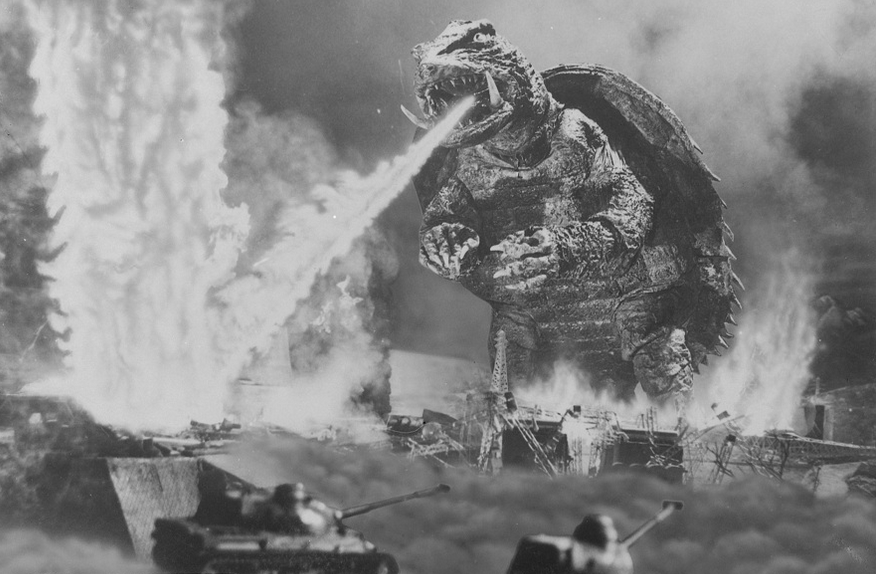


The film was a quick few bucks for both Donlevy and Dekker. Brian Donlevy had only six more movies to make. One of the six was the Chinese made 1967 "Five Golden Dragons". That was an International Crime Drama with Christopher Lee, George Raft, and Dan Duryea joining Donlevy in cameo's as four of the five title characters. The picture actually starred another old movie and television actor Robert Cummings.
Brian Donlevy passed away in Woodland Hills, California, at the age of 71 on April 5, 1972.

Above an attack on a light house. Can you again say "The Beast from 20,000 Fathoms", again?

Can anyone stop him, before he destroys the country and others? That is when "Plan Z" is put into effect. It will trap him and send Gamera, or Gammera, to Mars.



The film was a quick few bucks for both Donlevy and Dekker. Brian Donlevy had only six more movies to make. One of the six was the Chinese made 1967 "Five Golden Dragons". That was an International Crime Drama with Christopher Lee, George Raft, and Dan Duryea joining Donlevy in cameo's as four of the five title characters. The picture actually starred another old movie and television actor Robert Cummings.
Brian Donlevy passed away in Woodland Hills, California, at the age of 71 on April 5, 1972.





No comments:
Post a Comment